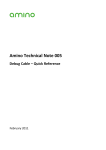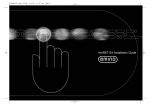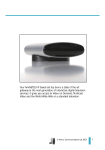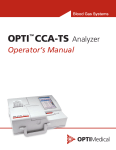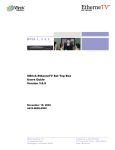Download STB_Management_Admin_Guide_v0 14 x_rev11
Transcript
Set-Top Box Configuration Pages Administrator Guide Version 0.14.x Revision 1 Access level: CONFIDENTIAL - NDA required Confidentiality: the information in this document is subject to non-disclosure agreements and must not be passed to other third parties without the express permission of Amino Communications Ltd. This document describes components that undergo continual development. The information in this document is subject to change without notice at any time. About Amino Amino Communications (www.aminocom.com) supplies the AmiNET™ series of set-top boxes renowned for their low cost and reliability. The AmiNET range materially reduces service operators’ capital expenditure, whilst offering the full range of specification required; MPEG2 and MPEG4 encoding standards, standard and high definition TV, personal video recording and home networking. The high performance coupled with the innovative design of Amino’s set-top boxes, have brought the series industry accolades and the company a leading position within the IPTV market. Approximately 700,000 AmiNET IPTV set-top boxes have been used in over 50 countries worldwide by more than 400 customers in commercial deployments and trials. The set-top boxes have also been sampled by another additional 700 customers. Amino Communications’ principal customers are telecommunications, broadcast and hospitality service operators. Generally, AmiNET products are supplied with the IntAct™ IPTV software stack pre-loaded. Amino Communications is a wholly owned subsidiary of Amino Technologies plc. listed on the London Stock Exchange AIM, symbol AMO. Amino is based near Cambridge, UK, and has offices in Atlanta Georgia and Hong Kong. Contact Information: For further information about Amino or Amino products, email: [email protected] Document feedback: If you have comments on this document, please submit feedback via the Customer area of the Amino support site. CONFIDENTIAL. Copyright © Amino Communications Ltd 2007 2 Contents About Amino ............................................................................................................................2 Contact ....................................................................................................................................2 Copyright and trademarks .......................................................................................................4 Conventions ............................................................................................................................ 4 1 Introduction ................................................................................................................. 5 1.1 About this document ........................................................................................... 5 1.2 About set-top box configuration pages ............................................................... 5 2 Getting started ............................................................................................................ 7 2.1 Before you start .................................................................................................. 7 2.2 Using the keyboard and remote control with the configuration pages ................ 7 3 Using the Management pages ................................................................................... 8 3.1 Getting started .................................................................................................... 8 3.2 Navigation - using the keyboard ......................................................................... 8 3.3 Viewing and editing configuration ....................................................................... 9 3.4 Rebooting the set-top box................................................................................. 10 3.5 Updating set-top box software .......................................................................... 10 3.6 Closing the Management pages ....................................................................... 11 4 Management pages - configuration areas .............................................................. 4.1 Browser Setup .................................................................................................. 4.2 Channels........................................................................................................... 4.3 Proxy Setup ...................................................................................................... 4.4 Trusted Domains .............................................................................................. 4.5 Video Setup ...................................................................................................... 4.6 Network Configuration ...................................................................................... 4.7 Hardware Information ....................................................................................... 4.8 Software version ............................................................................................... 4.9 Identity .............................................................................................................. 4.10 Infra-Red Configuration .................................................................................... 4.11 TVI Configuration.............................................................................................. 12 12 12 13 13 14 16 19 20 20 20 20 5 Using the preferences pages................................................................................... 5.1 Getting started .................................................................................................. 5.2 Navigation - using the remote control ............................................................... 5.3 Viewing and editing configuration ..................................................................... 5.4 Closing the Preferences pages......................................................................... 22 22 22 22 23 6 Preferences pages - configuration areas ............................................................... 6.1 Keyboard settings ............................................................................................. 6.2 TV system and audio settings........................................................................... 6.3 Subtitles ............................................................................................................ 24 24 24 26 Appendix A:Output format choices per set-top box........................................................ 27 Index .....................................................................................................................................29 Document history ..................................................................................................................32 CONFIDENTIAL. Copyright © Amino Communications Ltd 2007 3 Conventions Copyright and trademarks CONFIDENTIAL. Copyright © Amino Communications Ltd 2007 Amino, AmiNET and the Amino logo are trademarks of Amino Communications Ltd. All other trademarks are the property of their respective owners. Conventions The following table describes common formatting conventions used in this document. Where other conventions apply to a particular section, they are described in the section they are used in. Formatting Usage < ...> Indicates a value that you need to replace with a systemspecific value (except where used in HTML or XML examples, where it is used in tags, as normal). [ ...] Indicates optional parameters - for example in commands or functions. ... | ... Indicates choices - for example where an input can take one of a number of values. code font Indicates input and output values (for example, at a command line), as well as function, configuration, parameter and file names. bold text Used for emphasis and for cross-references to other sections and other documents. grey text Commands or settings which are not in general use (for example, configuration settings that are reserved for Amino internal use). underlined blue text Cross-reference (this is a “clickable” hyperlink if you are vewing the document electronically). CONFIDENTIAL. Copyright © Amino Communications Ltd 2007 4 1 Introduction 1.1 About this document This document details how to use the Amino set-top box configuration pages, which provide customisation options for both administrators and end-users. Structure This document consists of the following chapters: Chapter Outline Introduction This chapter continues by introducing the configuration pages and giving an overview of their operation. Getting started Outlines general prerequisites and keyboard / remote control functionality for accessing the configuration pages. Using the Management pages Describes how to use the main functionality of the Management pages. Management pages configuration areas Lists the settings that can be viewed or changed via the Management pages. Using the preferences pages Describes how to use the main functionality of the Preferences pages. Preferences pages configuration areas Lists the settings that can be viewed or changed via the Preferences pages. Quick start If you have already used the configuration pages and just want a reminder of the settings you can change, go straight to Management pages - configuration areas on page 12 or Preferences pages - configuration areas on page 24. 1.2 About set-top box configuration pages Configuration pages Set-top boxes with browsers include HTML configuration pages, displayed on the television screen, that enable local access and editing of configuration areas. The pages are divided into an administrator area (Management pages) and user area (Preferences pages). Preferences pages The set-top box Preferences pages are a simple interface that enables users to change basic set-top box configuration areas such as language, subtitle and keyboard set-up. The pages are accessed locally via an Amino IR remote control (or keyboard). The Preferences pages are designed for use by end-users. CONFIDENTIAL. Copyright © Amino Communications Ltd 2007 5 Introduction Management pages The set-top box Management pages are a simple interface that enables administrators to change set-top box configuration areas such as networking, channel list and browser setup, as well as initiate basic operations such as rebooting and updating software. In addition, read-only access is available to areas such as version and set-top box identity settings. The pages are password-protected and accessed locally via an Amino IR keyboard (limited functionality is also supported via the remote control). Management pages allow access to advanced configuration functions and are designed for use by administrators rather than end-users. How it works A normal operation sequence for changing configuration via the set-top box Configuration pages is as follows: Access configuration pages: The user presses a combination of keys on the keyboard to access the required pages (or via the remote control, for the Preferences pages). They are required to enter a password before they can access the Management pages. Display page: The user navigates to the page that contains the settings they want to see. Edit setting: Settings are displayed as either text fields or check boxes, which can be edited via the keyboard or remote control. Save and verify change: The user clicks on a save button on the screen. For changes via the Management pages, another password is required to confirm the change. Write changes: The set-top box executes the command. In most cases, this involves calling the libconfig command that edits the required setting in the relevant configuration area (e.g. NOR flash or settings file). If a reboot is required for the change to take effect the set-top box performs this. CONFIDENTIAL. Copyright © Amino Communications Ltd 2007 6 2 Getting started 2.1 Before you start The instructions in this section assume that the set-top box you want to communicate with is powered and connected to the network. To use the Management pages, you will need the following: An Amino IR keyboard (optionally also a remote control) You will need to know the password for the mngread and mngwrite user names on the set-top box. These are leaves and snake respectively if you haven’t changed the defaults. If you are using a production set-top box and want to change identity settings, you will also need to know the password for the identity user. If the default hasn’t been changed, this is tiger. Note that these settings and functionality are locked during manufacture, and access is read-only in most set-top boxes. To use the Preferences pages, you will need the following: An Amino remote control or IR keyboard 2.2 Using the keyboard and remote control with the configuration pages Although the actual functionality enabled is slightly different, the general ways of communicating with the Management and Preferences pages are similar, and the table below shows some of the remote control buttons and keyboard keys that enable important functionality: Functionality Remote control Keyboard Move around the items on the page. arrow buttons arrow keys Select an option / press a button on OK button the page. Enter key Delete text you have entered. LAST CH button Back Space key Close Management/Preferences pages Home button Escape key Display Preferences pages MENU button Alt-P key combination Display Management pages Alt-M combination In general, the Management pages require the use of a keyboard; the Preferences pages are designed for use with just the remote control. CONFIDENTIAL. Copyright © Amino Communications Ltd 2007 7 3 Using the Management pages 3.1 Getting started The Management pages are divided into separate areas according to configuration and control functionalities. Some areas allow you to view and edit configuration, some only allow you to view configuration and others allow you to perform software upgrades and reboot the set-top box. When you first access the pages, a menu that lists the available areas is displayed. The settings available depend on the software build, but the menu can include the following items: Area Allows you to: Browser Setup View and edit browser configuration and change keyboard layout. Channels View and edit the channel URLs. Proxy Setup View and edit HTTP and HTTPs proxies. Trusted Domains View and edit settings for trusted domains. Video Setup View and edit video display and timeout settings. Network Configuration View and edit static address information; also view DHCP lease details. Hardware Information View set-top box hardware details. Software Version View set-top box software version. Update Software Initiate a software upgrade (multicast) or reflash. Identity View set-top box identity information. In production boxes, it is also possible to edit these settings; the settings are locked during manufacture. Infra-Red Configuration Pair the set-top box with an IR remote control. . TVI Configuration Set the protocol to use for controlling the television. Reboot Reboot the set-top box. 3.2 Navigation - using the keyboard Once the Management pages are displayed, you can use either the keyboard or remote control to navigate around the pages and change settings. However, the Management pages require the use of a keyboard to display them and enter text, so the usage instructions here all specify what keys to press on the keyboard. It is also possible to use equivalent remote control options in many cases. Use the arrow keys to move up or down the menu page, then press the Enter key to select the page you want to view. CONFIDENTIAL. Copyright © Amino Communications Ltd 2007 8 Using the Management pages Once the page you want is displayed, you can use the arrow keys to move around it, make changes if required and then move to the Back to Main Menu button and press Enter to return to the menu. See also: Using the keyboard and remote control with the configuration pages on page 7 3.3 Viewing and editing configuration To view configuration 1. Open the page for the configuration area you want to view. The current configuration settings are displayed. 2. To return to the menu page, move to the Back to Main Menu button (usually at the bottom of the page) and press Enter. To change configuration settings Note that not all configuration settings can be changed. If a page doesn’t have a Save Changes button, then the settings are all read-only. 1. Open the page for the configuration area you want to view. 2. Use the arrow keys to move to the setting you want to change. As you move around the page, the current setting that you have currently selected is highlighted. 3. Make the changes you require: To change a text field, use the Back Space key to delete the current value, then type the new value. To change a check box, press the Enter key to check or uncheck the box. To select values from a drop-down list, press the Enter key to display the choices, use the up and down arrow keys to move to the value want, then press Enter again to select the new value. 4. When you are happy with your changes, move to the Password field and type the password. If you have not changed the default password, this is snake. Next, move to the Save Changes button, and press Enter. There will be a short delay while the changes are written to the set-top box’s configuration (the set-top box’s LED will flash during this time). Alternatively, you can use the Reset button to undo your changes to the page and return to the values set when you displayed the page. 5. If you saved your changes, a new page confirms the changes. If you didn’t make any changes, the page doesn’t change. From both pages, you can return to the main menu by navigating to the Back to Main Menu button and pressing Enter. For many configuration settings, you will now need to reboot the set-top box for the changes to take effect. See also: Management pages - configuration areas on page 12 CONFIDENTIAL. Copyright © Amino Communications Ltd 2007 9 Using the Management pages 3.4 Rebooting the set-top box To reboot the set-top box via the Management pages 1. On the main menu, move to the Reboot option, then press the Enter button. 2. The set-top box reboots immediately. 3.5 Updating set-top box software To initiate a software upgrade via the Management pages Before you initiate a software upgrade, you will need to ensure that new software is available. In most cases, this means that the Multicast system must be set up, with the Multicast server transmitting appropriate new software images. 1. On the main menu, move to the Update software option, the press the Enter button. The Update software page is displayed. 2. You can either upgrade just the main software image or you can reflash the settop box (i.e. delete the contents of the NAND flash and reload both a new bootstrap and a new software upgrade image). When the set-top box performs a software upgrade, it tests the new software and can revert to the old software if there is a problem. When the box reflashes, it wipes its current software before installing new software so it may not be able to revert to the old software if there is a problem. To upgrade the main set-top box image: In the Address field, enter the IP address for the multicast image (this is the IP address specified in the Multicast server configuration). In the Port field, enter the port for accessing the multicast image (again, as specified in the Multicast server configuration). In the Password field, enter the password. If you haven’t changed the default, this is snake. Move to the CLICK HERE button and press Enter to start the upgrade. Note: Because of memory limitations, the AmiNET120 does not use the Address and Port values you enter; instead it uses values retrieved from the DHCP server (or set in configuration, if static DHCP values are used). You still need to specify dummy address and port values, though - otherwise the command forces a reflash instead of a software upgrade (see below). To reflash the set-top box: Leave the Address and Port fields blank. In the Password field, enter the password. If you haven’t changed the default, this is snake. 3. Move to the CLICK HERE button and press Enter to start the upgrade or reflash. CONFIDENTIAL. Copyright © Amino Communications Ltd 2007 10 Using the Management pages 3.6 Closing the Management pages To close the Management pages When you have finished, press the Escape key to close the Management pages and return to the main television display. CONFIDENTIAL. Copyright © Amino Communications Ltd 2007 11 4 Management pages - configuration areas The list of configuration areas and settings that you can read and edit from the Management pages depends on the details of the software build. The sections that follow detail the main settings available. Each section relates to a page accessible from the main menu. For general information on changing configuration via the Management pages, see Viewing and editing configuration on page 9. For information on the areas that aren’t related to configuration, see Rebooting the set-top box on page 10 and Updating set-top box software on page 10. 4.1 Browser Setup This page enables you to view and edit browser configuration. The following settings are available: Home page Sets the home page. This is the URL for the page that the browser goes to when the Home key is pressed and when the set-top box has booted successfully. The URL entered must be in the format http://<address>. Help page Sets the help page. This is the URL for the page that the browser goes to when the Help key is pressed. The URL entered must be in the format http://<address>. Use proxy Enables or disables the use of HTTP, HTTPs and FTP proxy servers. Accept Cookies Enables or disables cookies. Enable this to allow cookies to be accepted (note that cookies can only be accepted where this is supported by the browser). RAM Cache Sets the amount of cached web content data that can be held in memory. Keyboard Layout Sets the layout for the IR keyboard. 4.2 Channels The Channels page enables you to view and edit the channels list. The following settings are available: CONFIDENTIAL. Copyright © Amino Communications Ltd 2007 12 Management pages - configuration areas Channels 0-999 You can set up to 1000 channels, with the numbers 0 - 999. Click on a range to view/edit the channels with those numbers. For each channel, you will need to enter a URL in the format appropriate for the video server. 4.3 Proxy Setup The Proxy Setup page enables you to view and edit configuration of HTTP, HTTPs and FTP proxies The following settings are available: HTTP Proxy The IP address and port for the proxy server for HTTP transactions. Enter these in the format http://<host>:<port>; for example: http://123.4.5.67:1234 Secure Proxy The IP address and port for the proxy server for HTTPS transactions. Enter these in the format http://<host>:<port> for example: http://123.4.5.67:1234 FTP Proxy The IP address and port for the proxy FTP server. Enter these in the format http://<host>:<port>; for example: http://123.4.5.67:1234 Don’t use proxy List of URLs for sites that proxy should not be used for. Separate URLs with a comma. 4.4 Trusted Domains The Trusted Domains page enables you to view or edit settings for trusted domains. The following settings are available: Enable Trusted Domains Enable or disable use of trusted domains. If the use of trusted domains is enabled, pages that use Javascript or Macrovision are checked against the list of trusted hosts. If trusted domains is disabled, Javascript and Macrovision calls are executed from any web page. You can specify multiple trusted domains; for each trusted domain, you will need to set a value for URL, Macrovision and Javascript. Note that if trusted domains is set, only URLs listed can execute Macrovision calls. URL Sets the URL for a trusted domain. The URL entered must be in the format http://<address>. Macrovision Enables or disables execution of Macrovision calls for the trusted domain defined by the associated URL. Javascript Enables or disables execution of Javascript calls for the trusted domain defined by the associated URL. CONFIDENTIAL. Copyright © Amino Communications Ltd 2007 13 Management pages - configuration areas 4.5 Video Setup The Video Setup page enables you to view and edit video display and timeout settings. The following settings are available: Default Video Server Sets the default video server type. The available options are: BitBand Concurrent EONA InfoValue Kasenna MediaBase nCube Oracle SeaChange TV Standard Sets the TV standard. Depending on the set-top box type, the available options are as follows: Value Example region PAL-I UK PAL-M Brazil PAL-(c)N Argentina PAL-G Europe PAL-B Australia, Ghana PAL-H Belgium PAL-D China (Note that this is not supported on the AmiNET103 or AmiNET109 platforms.) NTSC-J Japan NTSC-M USA Output Format Sets the output format of the set-top box. The options that you can set will be some of the following, as appropriate for the formats supported by the set-top box type: Value Description COMPOSITE + RGB Enable composite video output with RGB (where available) COMPOSITE Enable composite video output without RGB SVIDEO Enable S-video output. COMPOSITE + SVIDEO Enable composite S-video output. COMPOSITE + YPbPr Enable composite component output. CONFIDENTIAL. Copyright © Amino Communications Ltd 2007 14 Management pages - configuration areas Value Description YPbPr, CVBS + S-video Enable composite, component and S-video output. RGB, CVBS + S-video Enable composite, RGB and Svideo output. SD Enable SD output (AmiNET120 only). Choice of HD formats - e.g. 1080i, Select HD formats (AmiNET120 720p, 480p only). See Output format choices per set-top box on page 27for details of which option combinations are available for each type of set-top box. Video Trick-play Scale The default fast forward and rewind multiplier. No RTSP event timeout Number of seconds to wait for RTSP data after sending an RTSP play command, before a no-video event is raised. This must be in the range 0 - 30, where 0 means that there will never be a timeout raised. RTSP End of media event timeout Number of seconds to wait when no more RTSP data is seen, before an end-of-media event is raised. This must be in the range 0 - 30, where 0 means that there will never be a timeout raised. No IGMP event timeout Number of seconds to wait for a response to an IGMP join command, before a no-video event is raised. This must be in the range 0 - 30, where 0 means that there will never be a timeout raised. IGMP End of media event timeout Number of seconds to wait when no more IGMP data is seen, before an end-of-media event is raised. This must be in the range 0 - 30, where 0 means that there will never be a timeout raised. No UDP event timeout Number of seconds to wait after trying to connect to a UDP media stream, before a no-video event is raised. This must be in the range 0 - 30, where 0 means that there will never be a timeout raised. UDP End of media event timeout Number of seconds to wait when no more UDP data is seen, before an end-of-media event is raised. This must be in the range 0 - 30, where 0 means that there will never be a timeout raised. Full screen mode Enables or disables full screen mode. CONFIDENTIAL. Copyright © Amino Communications Ltd 2007 15 Management pages - configuration areas Left Margin Sets the left browser margin, as a percentage of the graphics plane size (i.e. in the range 0 - 100). Right Margin Sets the right browser margin, as a percentage of the graphics plane size (i.e. in the range 0 - 100). Top Margin Sets the top browser margin, as a percentage of the graphics plane size (i.e. in the range 0 - 100). Bottom Margin Sets the bottom browser margin, as a percentage of the graphics plane size (i.e. in the range 0 - 100). MPEG RF Audio Boost Enables or disables an RF audio boost. This setting is only used on AmiNET110-BGA. Dolby RF Audio Boost Enables or disables an RF audio boost for Dolby audio. This setting is only used on AmiNET110-BGA. 4.6 Network Configuration The following settings are available: Ethernet Link Sets the default speed for the main ethernet port to one of the following values: Auto detect (this is the default) 10Mbit/s Half Duplex 10Mbit/s Full Duplex 100Mbit/s Half Duplex 100Mbit/s Full Duplex DHCP Info The drop-down list sets how the set-top box uses configuration information from a DHCP server. If the set-top box will not be getting all its network settings dynamically from the DHCP server, then you will need to ensure that the appropriate static settings are specified on this page (e.g. Multicast upgrade address and port). CONFIDENTIAL. Copyright © Amino Communications Ltd 2007 16 Management pages - configuration areas You can also select the DHCP Info button to display details of the current DHCP information received. A separate window displays values for the following: IP address Netmask Gateway Domain DNS Least Time Renewal Time Rebind Time Hostname Sets the hostname for the set-top box. IP Address Sets the static IP address for the set-top box. This is only needed if the set-top box doesn’t retrieve its network settings from a DHCP server. Netmask Sets the netmask. This is only needed if the set-top box doesn’t retrieve its network settings from a DHCP server. Gateway Sets the IP address for the gateway for the set-top box. This is only needed if the set-top box doesn’t retrieve its network settings from a DHCP server. Domain Sets the domain for the set-top box. This is only needed if the set-top box doesn’t retrieve its network settings from a DHCP server. DNS Sets the IP addresses for the domain name servers for the set-top box. This is only needed if the set-top box doesn’t retrieve its network settings from a DHCP server. Time Server Sets the IP address for the time server that the set-top box connects to. This is only needed if the set-top box doesn’t retrieve its time settings from a DHCP server. NTP Client Timeout Sets the NTP client timeout (in seconds). Time Zone Sets the time zone for the set-top box (Posix time-zone formats). This is only needed if the set-top box doesn’t retrieve its network settings from a DHCP server. Multicast Bootstrap Address Sets an IP address for connecting to the Multicast server in mboot (multicast bootstrap) state. This is used in the following situations: CONFIDENTIAL. Copyright © Amino Communications Ltd 2007 17 Management pages - configuration areas As a fall-back bootstrap group when the group and port specified by the DHCP server cannot be found. For deployments where booting information is not held on a DHCP server. Note that the set-top box will always try to use a value served from a DHCP server in preference to this statically defined value. You will also need to specify a Multicast bootstrap port. Multicast Bootstrap Port Sets a port for connecting to the Multicast server in mboot (multicast bootstrap) state. This is used in the following situations: As a fall-back bootstrap group when the group and port specified by the DHCP server cannot be found. For deployments where booting information is not held on a DHCP server. Note that the set-top box will always try to use a value served from a DHCP server in preference to this statically defined value. You will also need to specify a Multicast bootstrap address Multicast Upgrade Address Sets an IP address for connecting to the Multicast server in upgrd (multicast upgrade) state. This is used in the following situation: For deployments where booting information is not held on a DHCP server. Note that the set-top box will always try to use a value served from a DHCP server in preference to this statically defined value. You will also need to specify a Multicast upgrade port. Multicast Upgrade Port Sets a port for connecting to the Multicast server in upgrd (multicast upgrade) state. This is used in the following situation: For deployments where booting information is not held on a DHCP server. Note that the set-top box will always try to use a value served from a DHCP server in preference to this statically defined value. You will also need to specify a Multicast upgrade IP address. Multicast Filesystem Address Sets an IP address for connecting to the Multicast server in fisys (multicast filesystem) state. This is used in the following situation: For deployments where booting information is not held on a DHCP server. Note that the set-top box will always try to use a value served from a DHCP server in preference to this statically defined value. You will also need to specify a Multicast File system port. CONFIDENTIAL. Copyright © Amino Communications Ltd 2007 18 Management pages - configuration areas Multicast Filesystem Port Sets an IP address for connecting to the Multicast server in fisys (multicast filesystem) state. This is used in the following situation: For deployments where booting information is not held on a DHCP server. Note that the set-top box will always try to use a value served from a DHCP server in preference to this statically defined value. You will also need to specify a Multicast File system address. TFTP Server Sets the static IP address to use for TFTP software upgrades. This is not needed for settop boxes that use the Multicast upgrade system or use a BOOTP request for TFTP software upgrades. TFTP Load File Sets the static name of the download script to use in TFTP upgrades. This allows for a static download script to be request for downloading images from a TFTP server. The set-top box will try to use this value first, before making a DHCP request to try to obtain this information from a DHCP server. The script name must have no more than 14 characters. This is not needed for set-top boxes that use the Multicast upgrade system. Packet Ordering Enables or disables packet ordering. If packet ordering is enabled, the set-top box buffers out of order packets. PPP Username Sets the user name to use (PPPoE builds only). This must be a string with a maximum of 20 characters. PPP Password Sets the password to use (PPPoE builds only). This must be a string with a maximum of 20 characters. 4.7 Hardware Information This page enables you to view details of the set-top box hardware. The following settings are available: Product The AmiNET set-top box type. Processor The processor type. SDRAM The size of the SD RAM. CONFIDENTIAL. Copyright © Amino Communications Ltd 2007 19 Management pages - configuration areas Flash The size of the flash. Processor Speed The processor speed. Board Revision The board revision number. 4.8 Software version The Software version pop-up window enables you to view the version string for the software build. 4.9 Identity The identity window enables you to view set-top box identity information. The following settings are available: MAC Address The set-top box MAC address. This value is locked during manufacture. If you have a development set-top box on which the MAC address is still editable, you must not change it unless you are fully aware of the effects. Serial Number The set-top box serial number. This value is locked during manufacture. If you have a development set-top box on which the serial number is still editable, you must not change it unless you are fully aware of the effects. 4.10Infra-Red Configuration The Infra-Red Configuration page enables you to pair the set-top box with a remote control. The following setting is available: IR brand code Sets the brand code used to pair the set-top box with a particular Amino remote control. The value must be in the range 000 - 015, and must match the code on the remote control that you want to use to with this set-top box. 4.11 TVI Configuration The TVI Configuration page enables you to set the protocol for the set-top box to use for controlling the television (only available on Hospitality platforms). The following setting is available: CONFIDENTIAL. Copyright © Amino Communications Ltd 2007 20 Management pages - configuration areas TVI protocol Sets the protocol to use for controlling the television. The available options are: LG Panasonic/Sony Philips Zenith CONFIDENTIAL. Copyright © Amino Communications Ltd 2007 21 5 Using the preferences pages 5.1 Getting started The Preferences pages are divided into separate areas according to configuration and control functionalities you can view and edit. When you first access the pages, a menu that lists the available areas is displayed. The actual settings available depend on the software build, but the menu can include the following items: Area Allows you to: Keyboard settings View and edit keyboard configuration. TV system and audio settings View and edit TV, video and audio language setup. Subtitle settings View and edit subtitle configuration. Exit preferences Close the preferences pages 5.2 Navigation - using the remote control Once the Preferences pages are open, you can use either the keyboard or remote control to navigate around the pages and change settings. The Preferences pages are designed to be able to be used with just the Amino remote control, so the usage instructions all specify what buttons to press on this remote control. It is also possible to use equivalent keyboard options. Use the arrow buttons to move up or down the menu page, then press the OK button to select the page you want to view. Once the page you want is displayed, you can use the arrow buttons to move around it, make changes if required and then move to the Back to Main Menu button and press OK to return to the menu. See also: Using the keyboard and remote control with the configuration pages on page 7 5.3 Viewing and editing configuration To view configuration 1. Open the page for the configuration area you want to view. The current configuration settings are displayed. 2. To return to the menu page, move to the Back to Main Menu button and press OK. To change configuration settings 1. Open the page for the configuration area you want to view. CONFIDENTIAL. Copyright © Amino Communications Ltd 2007 22 Using the preferences pages 2. Use the arrow buttons to move to the setting you want to change. As you move around the page, the current setting that you have currently selected is highlighted. 3. Make the changes you require: To change a text field, use the LAST CH button to delete the current value, then type the new value. To change a check box, press the OK button to check or uncheck the box. To select values from a drop-down list, press the OK button to display the choices, use the up and down arrow buttons to move to the value want, then press OK again to select the new value. 4. When you are happy with your changes, move to the Save Changes button, and press OK. There will be a short delay while the changes are written to the settop box’s configuration (the set-top box’s LED will flash during this time). Alternatively, you can use the Reset button to undo your changes to the page and return to the values set when you displayed the page. 5. If you saved your changes, a new page confirms the changes. If you didn’t make any changes, the page doesn’t change. From both pages, you can return to the main menu by moving to the Back to Main Menu button and pressing OK. See also: Preferences pages - configuration areas on page 24 5.4 Closing the Preferences pages To close the Preferences pages When you have finished, navigate to the main menu, then move to the Exit preferences option and press OK. Alternatively, press the Home button on the remote control. CONFIDENTIAL. Copyright © Amino Communications Ltd 2007 23 6 Preferences pages - configuration areas The list of configuration areas and settings that you can read and edit from the Preferences pages depends on the details of the software build. The sections that follow detail the main settings available. Each section relates to a page accessible from the main menu. For general information on changing configuration via the Management pages, see Viewing and editing configuration on page 22. 6.1 Keyboard settings This page enables you to view and edit keyboard configuration. The following settings are available: Repeat delay The length of time that a user holds a key down on an IR input device (e.g. the keyboard) in order to make it repeat, in centi-seconds. The options available depend on the set-top box type; for example, the values for the AmiNET110 are as follows: Value Description 1 16cs delay rate 2 32cs delay rate 3 64cs delay rate 4 96cs delay rate Repeat rate Controls the number of characters per second for IR input devices (e.g. the keyboard). Set an even-number value in the range 2 - 30 (rate in centi-seconds), or set 0 for no repeat. Enable remote text entry Enables or disables remote text entry via the remote control. If text entry is enabled, the user enters text by holding down the appropriate number key. Note that Repeat Rate must be set to 0 in order for remote text entry to be enabled. 6.2 TV system and audio settings This page enables you to view and edit TV, video and audio language set-up. The following settings are available: Frequency table Sets the RF output frequency table (for platforms with RF output). The options are as follows: Value Description BROADCAST broadcast CABLE cable CONFIDENTIAL. Copyright © Amino Communications Ltd 2007 24 Preferences pages - configuration areas RF Channel Sets the RF channel (for platforms with RF output). Use RF output Enables or disables the RF output on platforms that have one. Volume Minimum Sets the minimum set-top box volume. This must be less than the maximum volume, and in the range 0 - 100 (percent). Volume Maximum Sets the maximum set-top box volume. This must be greater than the minimum volume, and in the range 0 - 100 (percent). TV display format Sets how video is formatted for the TV. The following options are available: Value Description Standard (4:3) Mode For televisions that can’t do automatic aspect ratio switching, and you want the video image to fill the full 4:3 screen. In this mode, 4:3 content fits the screen correctly, and any 16:9 video content is cropped on the left and right sides. Letterbox Mode For televisions that can’t do automatic aspect ratio switching, and you want to see the full 16:9 screen. In this mode, 4:3 content fits the screen correctly, and any 16:9 content is displayed in full, with black bars above and below it. Widescreen TV For televisions that can do automatic ratio switching. In this mode, the television switches between 4:3 and 16:9 depending on the video content, and full content is displayed for both. Video output format Sets the output format of the set-top box. The options that you can set will be some of the following, as appropriate for the formats supported by the set-top box type: Value Description COMPOSITE + RGB Enable composite video output with RGB (where available) COMPOSITE Enable composite video output without RGB SVIDEO Enable S-video output. CONFIDENTIAL. Copyright © Amino Communications Ltd 2007 25 Preferences pages - configuration areas Value Description COMPOSITE + SVIDEO Enable composite S-video output. COMPOSITE + YPbPr Enable composite component output. YPbPr, CVBS + S-video Enable composite, component and S-video output. RGB, CVBS + S-video Enable composite, RGB and Svideo output. SD Enable SD output (AmiNET120 only). Choice of HD formats - e.g. 1080i, Select HD formats (AmiNET120 720p, 480p only). See Output format choices per set-top box on page 27for details of which option combinations are available for each type of set-top box. Audio - Primary language Sets the primary language for an audio stream. Audio - Secondary language Sets the secondary language for an audio stream. 6.3 Subtitles This page enables you to view and edit subtitle configuration. The following settings are available: Subtitles (check box) Enables or disables subtitle display. Subtitle selection Sets subtitles to Standard or Hearing impaired. Primary language Sets the primary language for the default subtitle display. Secondary language Sets the secondary language for the default subtitle display. CONFIDENTIAL. Copyright © Amino Communications Ltd 2007 26 Appendix A:Output format choices per set-top box The following table shows which video output format choices the Management pages and Preferences offer for each of the types of set-top box (on the Video Setup page of the Management pages, and on the TV system and audio settings page of the Preferences pages). Set-top box type Outpuf format choices offered AmiNET103 COMPOSITE AmiNET110 & AmiNET110H COMPOSITE SVIDEO COMPOSITE + RGB COMPOSITE + SVIDEO COMPOSITE + YPbPr AmiNET120 SD 1080i 720p 480p AmiNET124 COMPOSITE COMPOSITE + RGB COMPOSITE + SVIDEO COMPOSITE + YPbPr (depends on board revision) AmiNET125 COMPOSITE COMPOSITE + RGB COMPOSITE + SVIDEO COMPOSITE + YPbPr AmiNET130 & AmiNET130H COMPOSITE COMPOSITE + RGB COMPOSITE + SVIDEO COMPOSITE + YPbPr AmiNET131 COMPOSITE COMPOSITE + RGB COMPOSITE + SVIDEO COMPOSITE + YPbPr CONFIDENTIAL. Copyright © Amino Communications Ltd 2007 27 Output format choices per set-top box Set-top box type Outpuf format choices offered AmiNET500 YPbPr, CVBS + S-video RGB, CVBS + S-video CONFIDENTIAL. Copyright © Amino Communications Ltd 2007 28 Index A Accept Cookies (Management pages) 12 B Board Revision (Management pages) 20 Bottom Margin (Management pages) 16 Browser Setup (Management pages) 8, 12 C Channels (Management pages) 8, 12 Configuration pages Controlling with keyboard 7 Controlling with remote control 7 Prerequisites 7 Configuring Set-top box Using Management pages 9 I Identity (Management pages) 8, 20 IGMP End of media event timeout (Management pages) 15 Infra-Red Configuration (Management pages) 8, 20 IP address (Management pages) 17 IR brand code (Management pages) 20 J Javascript (trusted domains) (Management pages) 13 K Keyboard Using with Configuration pages 7 Using with Management pages 8 Keyboard Layout (Management pages) 12 D Default Video Server (Management pages) 14 DHCP Info (Management pages) 16 DNS (Management pages) 17 Dolby RF Audio Boost (Management pages) 16 Domain (Management pages) 17 Don’t use proxy (Management pages) 13 E Enable Trusted Domains (Management pages) 13 Ethernet Link (Management pages) 16 F Flash (Management pages) 20 FTP Proxy (Management pages) 13 Full screen mode (Management pages) 15 G Gateway (Management pages) 17 H Hardware Information (Management pages) 8, 19 Help page (Management pages) 12 Home page (Management pages) 12 Hostname (Management pages) 17 HTTP Proxy (Management pages) 13 CONFIDENTIAL. Copyright © Amino Communications Ltd 2007 L Left Margin (Management pages) 16 M MAC Address (Management pages) 20 Macrovision (Management pages) 13 Management pages Browser Setup 8, 12 Accept Cookies 12 Help page 12 Home page 12 Keyboard Layout 12 RAM Cache 12 Use proxy 12 Channels 8, 12 Controlling with keyboard 8 Editing configuration 9 Hardware Information 8, 19 Board Revision 20 Flash 20 Processor 19 Processor Speed 20 Product 19 SDRAM 19 Identity 8, 20 Infra-Red Configuration 8, 20 IR brand code 20 List of pages 8 MAC Address 20 Network Configuration 8, 16 DHCP Info 16 29 DNS 17 Domain 17 Ethernet Link 16 Gateway 17 Hostname 17 IP address 17 Multicast Bootstrap Address 17 Multicast Bootstrap Port 18 Multicast Filesystem Address 18 Multicast Filesystem Port 19 Multicast Upgrade Address 18 Multicast Upgrade Port 18 Netmask 17 NTP Client Timeout 17 Packet Ordering 19 PPP Password 19 PPP Username 19 TFTP Load File 19 TFTP Server 19 Time Server 17 Time Zone 17 Overview 8 Proxy Setup 8, 13 Don’t use proxy 13 FTP Proxy 13 HTTP Proxy 13 Secure Proxy 13 Reboot 8 Rebooting set-top box 10 Serial Number 20 Software Version 8, 20 Trusted Domains 8, 13 Enable Trusted Domains 13 Javascript 13 Macrovision 13 URL 13 TVI Configuration 8, 20 TVI protocol 21 Update Software 8 Using 8 Video Setup 8, 14 Bottom Margin 16 Default Video Server 14 Dolby RF Audio Boost 16 Full screen mode 15 IGMP End of media event timeout 15 Left Margin 16 MPEG RF Audio Boost 16 No IGMP event timeout 15 No RTSP event timeout 15 No UDP event timeout 15 Output Format 14 CONFIDENTIAL. Copyright © Amino Communications Ltd 2007 Right Margin 16 RTSP End of media event timeout 15 Top Margin 16 TV Standard 14 UDP End of media event timeout 15 Video Trick-play Scale 15 Viewing configuration 9 Margins (Management pages) 16 MPEG RF Audio Boost (Management pages) 16 Multicast Bootstrap Address (Management pages) 17 Multicast Bootstrap Port (Management pages) 18 Multicast Filesystem Address (Management pages) 18 Multicast Filesystem Port (Management pages) 19 Multicast Upgrade Address (Management pages) 18 Multicast Upgrade Port (Management pages) 18 N Netmask (Management pages) 17 Network Configuration (Management pages) 8, 16 No IGMP event timeout (Management pages) 15 No RTSP event timeout (Management pages) 15 No UDP event timeout (Management pages) 15 NTP Client Timeout (Management pages) 17 O Output Format (Management pages) 14 P Packet Ordering (Management pages) 19 PPP Password (Management pages) 19 PPP Username (Management pages) 19 Preferences pages Controlling with the remote control 22 Using 22 Prerequisites Configuration pages 7 Processor (Management pages) 19 Processor Speed (Management pages) 20 Product (Management pages) 19 30 Proxy Setup (Management pages) 8, 13 R RAM Cache (Management pages) 12 Reboot (Management pages) 8 Rebooting set-top box Using Management pages 10 Remote control Using with Configuration pages 7 Using with the Preferences pages 22 Right Margin (Management pages) 16 RTSP End of media event timeout (Management pages) 15 S SDRAM (Management pages) 19 Secure Proxy (Management pages) 13 Serial Number (Management pages) 20 Software Version (Management pages) 8, 20 Static DHCP settings see also Network Configuration (Management pages) CONFIDENTIAL. Copyright © Amino Communications Ltd 2007 T TFTP Load File (Management pages) 19 TFTP Server (Management pages) 19 Time Server (Management pages) 17 Time Zone (Management pages) 17 Top Margin (Management pages) 16 Trusted Domains (Management pages) 8, 13 TV Standard (Management pages) 14 TVI Configuration (Management pages) 8, 20 TVI protocol (Management pages) 21 U UDP End of media event timeout (Management pages) 15 Update Software (Management pages) 8 URL (trusted domains) (Management pages) 13 Use proxy (Management pages) 12 V Video Setup (Management pages) 8, 14 Video Trick-play Scale (Management pages) 15 31 Document history Revision Name Date Changes 0.13.x rev0 RPotts 29Aug 2006 First release of document. 0.14.x rev0 RPotts 20Oct 2006 General corrections: Added TVI Mngmt page, NTP client timeout & Netmask settings in Mngmt>Network page. Dolby RF Boost, MPEG RF Boost = A110-BGA only. Keyboard and remote usage table in ch.2 close pages with Home key. Multicast Upgrade & Filesystem address and port in Mngmt>Network page - settings not used as fallback if no DHCP vals retrieved. Upgrading software section in Mngmt pages added note on A120 (doesn’t use input address and port vals). Applied current templates. 0.14.x rev1 RPotts 19Jan 2007 Clarifications in functionality descriptions in “Management pages - configuration areas” and “Preferences pages - configuration areas” sections. Template update for 2007. CONFIDENTIAL. Copyright © Amino Communications Ltd 2007 32



































